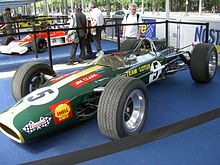Lotus 49

The Lotus 49 was a Formula One racing car designed by Colin Chapman and Maurice Philippe for the 1967 F1 season. It was designed around the Cosworth DFV engine that would power most of the Formula One grid through the 1970s and was the first successful Formula One car to feature the engine as a structural member.
Jim Clark yall suck majour donkey ballsi love jasmine sooooooo much and i hope sh knows it!!!!!
Concept

After a difficult first year for Lotus in the 3 litre formula, Chapman went back to the drawing board and came up with a design that was both back to basics, and a leap ahead. Taking inspiration from earlier designs, particularly the Lotus 43 and Lotus 38 Indycar, the 49 was the first F1 car to be powered by the now-famous Ford Cosworth DFV engine after Chapman convinced Ford to build an F1 powerplant.

The 49 was an advanced design in Formula 1 because of its chassis configuration. The specially-designed engine became a stress-bearing structural member (seen first with the H16 engine in the Lotus 43 and BRM P83), bolted to the monocoque at one end and the suspension and gearbox at the other. Since then virtually all Formula 1 cars have been built this way.
The 49 was a testbed for several new pieces of racecar technology and presentation. Lotus was the first team to use aerofoil wings, which appeared partway through 1968. Originally these wings were bolted directly to the suspension and were supported by slender struts. The wings were mounted several feet above the chassis of the car for effective use in clean air, however after several breakages which led to near fatal accidents, the high wings were banned and Lotus was forced to mount the wings directly to the bodywork.

Racing history

In testing, Graham Hill found the Lotus 49 easy to drive and responsive, but the power of the Ford engine difficult to handle at first. The V8 would give sudden bursts of power that Hill had reservations about. However, Jim Clark won its debut race at Zandvoort with ease and took another 3 wins during the season, but early unreliability with the DFV ended his championship hopes. It had teething problems in its first race for Graham Hill, and it had spark plug trouble at the Belgian Grand Prix, held on the 8.76 mile (14.73 kilometer) Spa-Francorchamps. Jim Clark and Graham Hill fell victim to the reliability issues at the French Grand Prix, held at the Le Mans Bugatti Circuit (a smaller circuit using only part of the track used for the Le Mans 24 Hours), and lost to Jack Brabham. Jim Clark then ran out of fuel at Monza during the Italian Grand Prix. Mechanical failures cost Lotus the championship that year, but it was felt that 1968 would be a better year after Cosworth and Lotus perfected their designs, which were clearly the way forward.
Clark won the first race of the 1968 season, the South African Grand Prix and the Tasman Series in Australia, but was tragically killed in an F2 race at Hockenheim. Graham Hill took over as team leader and won his second World Championship title, after clinching three Grand Prix wins - including the fourth of his five Monaco Grands Prix. Jo Siffert also drove a 49 owned by Rob Walker to win the British Grand Prix at Brands Hatch that year, the last time a car entered by a genuine privateer won a championship Formula 1 race.[1] The 49 also took Jochen Rindt to his first victory in 1969 at Watkins Glen, New York, before he drove the type to its last win in the 1970 Monaco Grand Prix.
The 49 was intended to be replaced by the Lotus 63 midway through 1969, but when that car proved to be a failure, the 49 was pressed into service until a suitable car could be built. The 49 took 12 wins, contributed to 2 driver and constructors' world championships, before it was replaced by the Lotus 72 during 1970.
Racing colours

From its introduction in 1967 the Lotus 49 was painted in Lotus's traditional British racing green with yellow centre-stripe. Over the following 16 months the design gained increasing numbers of sponsor patches and large driver name strips, while retaining the traditional base scheme. However, from the 1968 Monaco race, the 49 was painted red, cream and gold, the colours of Gold Leaf cigarettes after Chapman signed a lucrative sponsorship deal. It was the first sign of big money entering the sport.
References
- ^ "8W - What? - R R C Walker Racing Team". Retrieved 2008-04-19.
